Content |
|---|
History
The first records of Pointers in England they date from around 1650. The breed is believed to be the result of a cross between Spanish pointers, the English Foxhound, Greyhounds, St. Hubert Hound, Bulldog and various breeds of Setter.
The objective of the breeders was to develop an animal that combined the qualities of these different breeds, in particular the developed sense of smell and the physical constitution of the St. Hubert Hound; speed, the elegance and grace of Greyhound; the well-developed rib cage of the English Foxhound, as well as its resistance and ease of maintenance. Later, various breeds of Setters to improve the psychological characteristics of the English Pointer, since the first specimens were described as fierce.
Until the 18th century, this dog was used to search, locate and mark small game, like the rabbit, the hare or the fox. He worked in tandem with the Greyhounds and other racing dogs, which in turn were in charge of catching and killing prey.
At the beginning of the 18th century, with the development of the use of firearms for hunting birds, the hunters realized that the English Pointer stood out in the search, signaling and recovery of game birds, thanks mainly to its speed and its great resistance. So, was used primarily for this purpose.
The international diffusion of English Pointer
The English Pointer began to spread abroad in the second half of the 19th century.
It is especially at this time that the first specimens were imported to France by lovers of hunting dogs., like the gentlemen Merle, Bailly, Mayaudon, Caillard y Lambertye.
Although it is possible that the first specimens were imported much earlier by the colonists, the first official import of a English Pointer in the United States it dates from 1876. From England and with a white and lemon coat, the apt name of Sensation became the emblem of the famous dog show of the Westminster Kennel Club, which was founded the following year and is still today one of the most prestigious dog shows in the world. The breed quickly gained popularity among hunters for hunting quail.
In 1878, just two years after arriving in the United States, was accepted by the National American Kennel Club, the predecessor of the American Kennel Club (AKC). The English Pointer was one of the first nine breeds recognized by the AKC when it was founded in 1884. The other reference organization in the country, the United Kennel Club (UKC), recognized the breed in the early 20th century. But, was not up 1963 when the breed was officially recognized by the Fédération Cynologique Internationale (FCI), which supervises the national organizations of a hundred countries (including France, Belgium and Switzerland).
Physical characteristics
The English Pointer it is a large dog with a harmonious appearance, flexible and elegant. His body is well proportioned and his muscles well developed..
His tail is rather short, thick at the base and thin towards the tip. It is straight and follows the line of the back. When on the move, beats from side to side.
His head is flat and rests on a long, muscular neck. Profile, the length of the skull and muzzle are approximately equal.
The ears are medium in size, droopy and located just above the eyes. They are slightly pointed and thin, with visible veins.
The eyes are oval in shape, with a hazel color in light-coated individuals, brown on others. In all cases, give the dog a lively look.
The nose is generally black, but may be lighter in dogs with lemon and white fur. In all cases, their nostrils are wide open.
The coat of the English Pointer is short, dense, smooth, straight and shiny. Their fur is usually bicolor, mixing white and another color: lemon, orange, brown or black. Unicolor or tricolor individuals are rarer, but they are also recognized by the standard.
Last, sexual dimorphism is quite marked in this breed: males are larger and above all more massive than females.
Height and weight
-
▷ Male size: Of 63 to 69 cm.
▷ female size: Of 61 to 66 cm.
▷ Male weight: Of 20 to 30 kg
▷ female weight: Of 18 to 28 kg
Character and skills
The English Pointer he is a gentle companion, loyal and affectionate with his family. Get along especially well with children old enough to have learned to interact with animals, and is a tireless playmate for them. He is also very patient and gentle with them, even when they are unruly or even bullying you. But, it is much less suitable for young children due to its large size, since you can easily push them unintentionally. In any case, regardless of race, a dog should never be left alone with a very young child without adult supervision.
The English Pointer not only does he get along very well with family members, but also with other dogs of the same breed.
Sharing your everyday life with one of them is a great way to avoid boredom when your child is away from home.. In fact, they have a hard time tolerating loneliness: if left alone too often or for too long, they are very likely to develop separation anxiety, with destructive behavior as a consequence. Whether you share your home with another animal or not, only suitable for a master who generally spends most of his days away from home.
If you like to be around your family, the Pointer, on the other hand, is much more reserved and distant with strangers. Without showing aggressiveness towards them, does not deprive himself of barking when he perceives danger or a stranger approaches his place of residence. But, although their barking and large size can be a deterrent, his ability to attack when necessary is limited, which does not make them good guardians. On the other hand, is an effective warning dog. Living with a cat or a rodent is possible, as long as they have been raised together or are used to living with other animals from a young age. Otherwise, it is better to avoid taking the risk, since its strong hunting instinct could lead it to consider newcomers as prey. This is also how he sees pet birds and small animals he doesn't know, whether they cross your path on a walk or venture into your garden.
This temperament is obviously a good thing if employed as a hunter., but it also implies that he must be kept on a leash during walks as long as he does not obey when asked to return, otherwise it will start chasing small animals that pass. Having said that, even with a good recovery workout, cannot be completely trusted: your instincts can get stronger at any time. Thus, It makes sense to invest in a GPS-connected collar, so you can easily locate it if it goes out to sea, especially since then it can get far away, but not necessarily find my way back.
In any case, the fear that he may be deceiving his masters is no reason to limit his outings, since the remedy would be worse than the disease. In effect, to be balanced, the English Pointer must be able to dedicate at least one hour a day, for example through two or three walks and / or play sessions.
It is too active to be suitable for an elderly and / or very sedentary person, but its incredible speed and stamina make it a perfect companion for a very active master.. It is a pleasure to accompany you on jogging sessions, bike outings or long walks.
His curiosity and high intelligence also mean that physical activity is not enough.: to feel good both in your head and in your body, must also be intellectually stimulated. Ideally, you have a job to do or a mission to accomplish as often as possible.. Hunting and dog sports such as agility, obedience and rally are, Therefore, great ways to allow you to exercise both physically and mentally.
In any case, your activity level makes you unsuitable for apartment living, since you need to be able to run freely at all times in a wide space to expend your excess energy. So, need a house with a garden, but the garden must be well fenced, given his unbridled temper. Using an underground electric fence would not be an effective solution, because their determination is much stronger than the discomfort felt by electrical impulses, especially when he has sniffed a prey and goes after it.
And just because a dog likes to play in the garden doesn't mean they have to spend most of their time there., away from his family. To be happy and balanced, you need to be surrounded and interact with your family. It also, once your needs are met, he is quite calm and enjoys spending time with his masters, for example lying on the sofa receiving pampering.
Education
As in any race, Socialization should be one of the pillars of the education of the English Pointer and start at a young age, when it is most malleable and adaptable. So, you need to get used to being exposed to all kinds of different situations and environments, but also and above all to regularly meet other animals and new people. This is all the more necessary as he tends to be spontaneously shy around strangers..
The other way, to avoid any hyperapego to their owners, you should also teach your dog to tolerate loneliness. Otherwise, You may find it especially difficult to cope with your absences.
The intelligence of English Pointer makes you able to learn quickly. This does not mean that he is willing to comply with all the wishes of his master.: has a strong character and can be very stubborn, so sometimes it's hard to make him obey.
So, to achieve your goals - and, in particular, to get your dog to obey you- his master must be firm in his education and not let anything pass from the beginning, at the risk of ending up with a difficult partner. Pay special attention that the rules are clear from the start, but also constant over time and from one person to another, which requires good cooperation between family members.
In general, the ideal is to start learning as soon as you get home, opting for the dog training method based on positive reinforcement. In fact, not receptive to reprimands, and responds much better to stimuli and treats.
But, the different smells and sounds that you perceive around you also interest you very much, and soon catch your attention during training sessions. So, it is better to opt for frequent sessions, short and varied, in order to keep you focused on tasks at all times.
Difficulties in achieving what is expected of him make it not really recommended for an inexperienced person, since it would soon be difficult for him to hit.
In any case, given his strong hunting instinct, remembrance is one of the most important teachings you should receive. Prevents him from constantly chasing animals he considers prey and disregarding his master's orders. Although it remains difficult to hope that his ardor will be curbed in the 100% of the cases, it must be kept on a leash during walks as long as this order is not properly assimilated.
Health
The English Pointer It, in general, a robust and healthy animal, and their life expectancy, of 12 to 15 years, is rather in the high range of the average for dogs of this size. They can withstand the heat without difficulty, but their short fur makes them especially sensitive to cold and humidity. Thus, it is advisable to cover him with a dog coat when temperatures are low. In any case, it is not suitable for living in a region where the climate is especially cold for much of the year.
- The Hip Dysplasia, a joint malformation whose appearance may be favored by a hereditary predisposition. It produces pain and lameness that worsen over time, and favors the appearance of osteoarthritis as the animal ages;
- The metaphyseal osteopathy (or hypertrophic osteopathy), a bone disease that usually manifests itself as the animal grows and progresses rapidly. Besides lameness, can cause various symptoms such as high fever, anorexia or abnormal fatigue. The vital prognosis is good in mild forms of the disease, but much more reserved for the most serious cases;
- The stomach dilation-torsion syndrome, which occurs when the stomach swells and folds in on itself, blocking the evacuation of gases and interrupting blood circulation. Unless a vet intervenes quickly, it is usually fatal, so it is a vital emergency;
- The Addison's disease, an endocrine disorder that is sometimes inherited and is caused by destruction or atrophy of the adrenal glands. This gives rise to various symptoms that may suggest other pathologies.: vomiting, diarrhea, dejection, weightloss, anorexia, tremors… The acute form gives the animal little chance of survival, while a lifelong treatment helps fight the chronic form;
- The Hypothyroidism, a hormonal disease that causes a decrease in metabolism. Hypothyroidism is a hormonal disease that causes a decrease in metabolism and gives rise to various symptoms that vary from one individual to another.: exhausted, damaged fur, breathing difficulties, overweight… Requires lifelong treatment to alleviate or even prevent these symptoms;
- The epilepsy, a chronic disease of the nervous system that causes seizures whose manifestations can vary from time to time and from person to person. Although there is no cure, various treatments can reduce the intensity or number of seizures to such an extent that most people with this disease can lead normal lives;
- Aortic stenosis, a congenital and probably hereditary heart defect that causes heart failure. This anomaly is incurable, and the risk of syncope or heart attack in the affected animal is not negligible. However, there are medications to counteract the effects of heart failure and the risk of sudden death;
- Demodechia, dermatological disease due to overgrowth of Demodex Canis mites. Hairless spots may appear, itchy redness, blackheads and dandruff. The localized form usually heals itself, but if necessary -or in the case of a generalized form- medication and skin care can help;
- Allergies, whether they are respiratory, food, skin or contact. Symptoms and treatments depend on the type of allergy in question.;
Chondrodysplasia (or dwarfism), a genetic disease that causes underdevelopment of bones and cartilage. The latter causes the front and hind limbs to be shorter than normal.. There is no cure for this disease, but medication can ease the pain, and surgery may be suggested for the most severe cases to correct any deformation of the bones and vertebrae;
congenital deafness, which mainly affects white-coated dogs. Whether it affects one or both ears, is irreversible;
The ear infections, which are common in any dog with floppy ears.
- Progressive retinal atrophy, an incurable inherited disease that causes retinal degeneration. Causes progressive loss of vision, first at night and then during the day;
- The gland prolapse nictitante (or cherry eye), which corresponds to an inflammation of this lacrimal gland. The most common signs are the appearance of a small red ball in the inner corner of the eye and tearing. Can be treated with surgery;
- The entropion, which is a curvature of the edge of the eyelid towards the inside of the eye. It can be hereditary and causes pain, irritation and inflammation of the cornea and conjunctiva from repeated rubbing of the eyelashes and / or hairs on the fragile parts of the eye. This can be remedied with surgical intervention.;
- The waterfall, which mainly affects the elderly and corresponds to a clouding of the lens. If nothing is done, leads to progressive loss of vision, up to total blindness. But, an operation can allow the animal to regain correct vision.
It also, When the English Pointer used for hunting, you are obviously exposed to the risks that this activity implies – particularly that of injuries.
Having said that, although the list of conditions the breed is predisposed to may seem frightening at first glance, keep in mind that its prevalence remains low, so most of its representatives live in perfect health. This is confirmed by a study carried out in 2004 by the Kennel Club and the British Small Animal Veterinary Association, which showed that old age is the main cause of death in this breed. Old age alone accounts for a quarter of deaths, while cancers rank second and are implicated in around the 20% of the cases.
However, it is true that a large part of the diseases to which the breed is predisposed are or may be hereditary, which justifies favoring a serious breeder of English Pointer. In effect, not content with offering puppies quality socialization from their first weeks of life, a professional worthy of the name takes care that they do not suffer from a hereditary defect transmitted by their parents. To avoid this, has various genetic tests performed routinely on individuals you plan to breed, to avoid the transmission of a hereditary pathology and, of course, rule out those at risk. In addition to the test results in question, must be able to present a certificate of good health issued by a veterinarian, as well as details of the vaccinations administered, registered in the animal's sanitary or vaccination registry.
Once adopted, it must be ensured that the animal does not make any excessively long or intense physical effort during its growth, which usually lasts until 18 months. In effect, your bones and joints are then especially fragile; would run the risk of injury or developing malformations, with consequences that could last a lifetime. These may include, this could lead to the development of Hip Dysplasia, to which you are predisposed.
Last, throughout his life, the English Pointer must be taken at least once a year to the vet for a complete health check. This appointment is also an opportunity to carry out any necessary vaccine withdrawals.. At the same time, to prevent risks related to parasites (worms, ticks…), your owner must make sure to renew your deworming treatments whenever necessary.
Life expectancy
Of 13 to 14 years
Grooming
The English Pointer it is an easy breed of dog to take care of, and this is especially true for their fur. Brushing once a week with a special glove or a rubber brush is enough to remove dead hairs and spread the sebum all over his coat.. If rubbed gently with a chamois or soft cloth, will be bright. It is also the occasion to detect possible skin problems, that are frequent in him.
During your seasonal molt, in spring and autumn, hair loss is still moderate, but brushing frequency should be increased. Ideally, do it two or three times a week.
When properly cared for, the fur of the English Pointer does not get very dirty and rarely smells bad. So, no need to wash frequently: once or twice a year is enough, unless, of course, is dirty or smells bad. In any case, a mild shampoo designed specifically for dogs should always be used, to avoid damaging your skin with an unsuitable product. In fact, the pH of dog skin differs from that of human skin.
You have to pay special attention to their droopy ears, since this morphological peculiarity increases the risk of infections at this level (otitis, etc.). So, not only do they have to be inspected and cleaned at least once a week, but also spend time drying them every time they have been in contact with water or have spent a long time in a humid environment, to prevent moisture build-up.
The maintenance of your dog's ears and also the opportunity to check his eyes and clean them if necessary, in order to avoid the risk of infections.
It also, teeth should also be cleaned at least once a week with dog toothpaste and a toothbrush or pad. This helps limit the formation and accumulation of tartar., that favors the development of bad breath and various oral diseases. Ideally, brush your teeth several times a week or even daily.
Looking at its claws, the activity level of the English Pointer makes natural wear and tear normally enough to file them. But, as you age or are no longer as active as before, they can get too long and end up annoying or even hurting you. So, they must be examined regularly and cut with a file or nail clipper as soon as necessary. This is the case as soon as a kind of rattling sound is heard when walking on hard ground.
Whether the fur, the ears, the eyes, teeth or claws, do not hesitate to ask for the help of a professional (vet or groomer) to know the proper care of the English Pointer. It is also advisable to accustom your pet to being handled from a young age.
This facilitates not only grooming sessions, but also to be able to examine it easily every time you return from a long stay abroad, for example during a hunting day. In effect, this is important to make sure he is not injured or that there are no parasites or spikes stuck in his fur.
Food
As in the case of any race, the diet of English Pointer should fit your size, age, health and physical activity level, both in terms of the choice of products and the amount of food given each day. To maximize the chances of keeping your dog healthy, it is recommended to feed him with high quality croquettes or hamburgers that provide him with all the nutrition he needs.
Nutrient intake can vary significantly throughout the year. If used as a hunter, will use more energy during certain periods of the year, so your daily rations should be modified and increased, since the diet of a hunting dog is not the same as the usual. But, it is important to return to a normal amount of food once the season is over to avoid any risk of overweight in dogs.
In fact, but the English Pointer are not predisposed to obesity, it is advisable to monitor your weight every month to ensure that everything is fine at that level. This is even more important if you have been spayed, since the risk is then higher. In case the magnification is prolonged or even increased during several measurements in a row, it is necessary to take it to the vet to find out the cause of the problem and thus know how to remedy it. In any case, your diet and activity level may not be the cause, for example if weight gain is a symptom of an underlying disease.
In any case, diet is especially important when the dog is small and growing. Feeding them too much and / or giving them too much food can cause them to grow too fast, which can cause not only injuries, but also long-term problems with bones and joints, as deformities. On the other hand, improper nutrition can also cause potentially very damaging stunting.
Regardless of age, the ideal is, as with any dog, divide your daily ration into several meals. This is all the more essential since it is predisposed to the dilation-torsion of the stomach., which often follows the rapid absorption of a large amount of food. It also, to avoid the latter, meals should be taken in a quiet place and one hour away from any strenuous physical activity.
It also, the fact that it is not especially prone to obesity does not justify giving it food intended for humans (for example, table scraps), without ensuring that you can effectively meet your nutritional needs. Otherwise, it would do more harm than good, especially, of course, if the food is popular with humans but toxic to dogs.
Last, water must be available throughout the day and must be changed regularly to keep it fresh. If used for hunting, it is better to carry enough than to let him drink standing water.
Use
Before the 18th century, the English Pointer it was mainly used as Pointing Dogs for small game, like the rabbit, the hare or the fox. Thus, cared for possible prey and worked with racing dogs, who were in charge of hunting and catching them.
With the arrival of firearms in his native England in the early 18th century, began to be used more to target and retrieve game birds, function in which he stood out.
Even today, are still highly prized by hunters, who use it mainly as Pointing Dogs.
They are also found as pets. Its sweetness and affectionate character make the Pointer a very endearing companion, as long as his family can meet his great need for exercise and they are sufficiently present for him.
Their loyalty to their owners and their aloof and aloof demeanor with strangers, without depriving yourself of barking loudly when they approach, make it an excellent warning dog. But, its ability to act as a watchdog is limited by its lower propensity to attack in danger.
It is also a good companion for dog sports. Its competitive character and its resistance allow it to distinguish itself in disciplines such as canicross, el cani-VTT, obedience, the rally and agility.
Last, his elegance and his desire to please his masters also make him a sure value in canine beauty contests. In fact, he was already often seen at dog shows in the 19th century.
Price
The price of a puppy English Pointer varies between the 450 and 1.200 EUR, and the mean is around 900 EUR, without great differences between males and females. There are many breeders throughout Europe.
On the other hand, in Canada remain rare, so the number of individuals offered each year is quite limited. The amount requested usually ranges from 1200 and 3000 canadian dollars. So, the most pertinent option may be to buy in the United States, where a puppy can be acquired for between 1000 and 1500 USD. Then, you must ensure that you adhere to the regulations regarding the importation of a dog into Canada and note that transport and administrative costs are added to the purchase price.
regardless of the country, price differences from one individual to another are explained by their own characteristics (and in particular its greater or lesser conformity with the breed standard), but also by the reputation of the lineage from which they come, as well as the prestige of the breeding.
Characteristics "English Pointer"
Coexistence is important that you have with your new friend. Before considering the acquisition of a dog of the breed "English Pointer" you know certain factors. Not all breeds of dogs are apt to live in an apartment, you must take into account his character, their need for exercise, their interaction with other pets, their care and if you have small children, their level of tolerance towards them.
Adaptation ⓘ3.0 out of 5 stars (based on 1 review)
|
friendly dog ⓘ4.0 out of 5 stars (based on 1 review)
|
hair loss ⓘ3.0 out of 5 stars (based on 1 review)
|
|---|---|---|
Affection level ⓘ3.0 out of 5 stars (based on 1 review)
|
Need for exercise ⓘ4.0 out of 5 stars (based on 1 review)
|
Social need ⓘ4.0 out of 5 stars (based on 1 review)
|
Home ⓘ3.0 out of 5 stars (based on 1 review)
|
Toilet ⓘ2.0 out of 5 stars (based on 1 review)
|
Friendly with strangers ⓘ2.0 out of 5 stars (based on 1 review)
|
barking ⓘ3.0 out of 5 stars (based on 1 review)
|
Health ⓘ4.0 out of 5 stars (based on 1 review)
|
Territorial ⓘ3.0 out of 5 stars (based on 1 review)
|
Cat friendly ⓘ2.0 out of 5 stars (based on 1 review)
|
Intelligence ⓘ4.0 out of 5 stars (based on 1 review)
|
Versatility ⓘ4.0 out of 5 stars (based on 1 review)
|
Child friendly ⓘ4.0 out of 5 stars (based on 1 review)
|
Surveillance ⓘ2.0 out of 5 stars (based on 1 review)
|
joy ⓘ5.0 out of 5 stars (based on 1 review)
|
Images “English Pointer”
Videos “English Pointer”
Type and recognitions:
- FCI CLASSIFICATION: 1
- Group 7: British and Irish Pointers and Setters
- Section 2: 2.1 Pointer. With working trial.
Federations:
- – FCI – Group 7: Pointing Dogs. – Section 2: Continental Pointing Dogs. 2.1: Pointer ⓘ
- – AKC – Sporting ⓘ
- – ANKC – Group 3 (Gundogs) ⓘ
- – CKC – Sporting Dogs ⓘ
- – KC – Gundog ⓘ
- – NZKC – Gundog ⓘ
- – UKC – Gun Dogs ⓘ
FCI breed standard "English Pointer"
Alternative names:
1. Pointer (English).
2. Pointer (French).
3. Englische Pointer (German).
4. (em inglês: English Pointer), Pointer (Portuguese).
5. Perdiguero inglés (español).
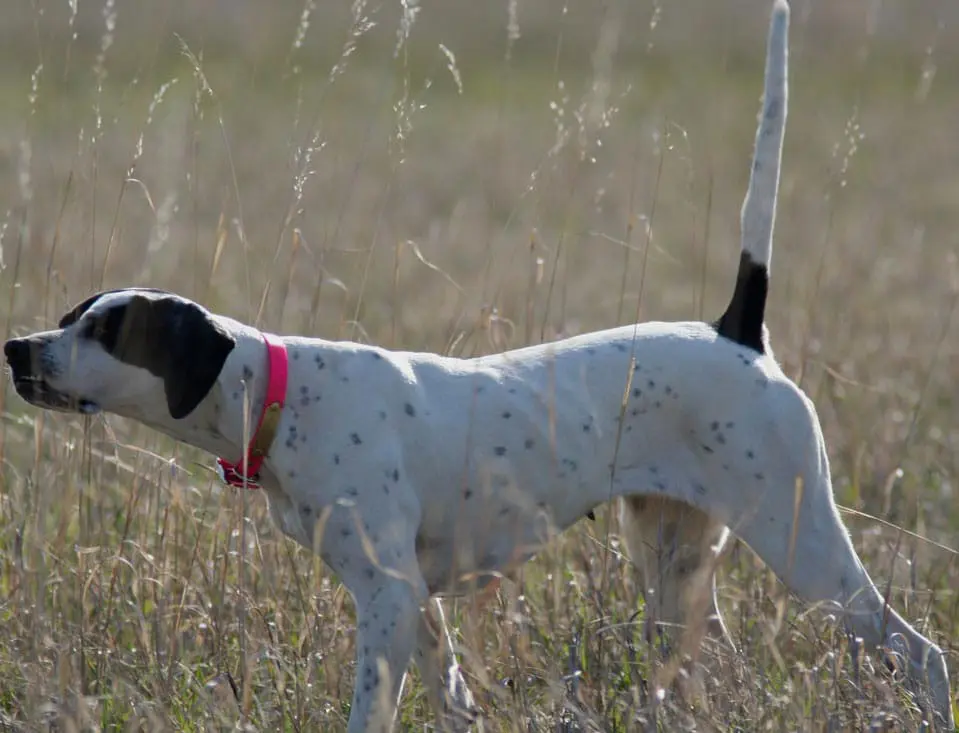
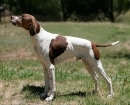
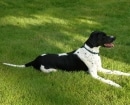

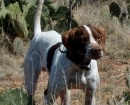
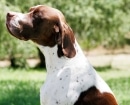
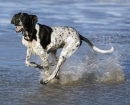
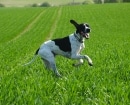

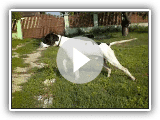 English pointer training and hunting (Purdey – 18 monthly, Hungary,)
English pointer training and hunting (Purdey – 18 monthly, Hungary,)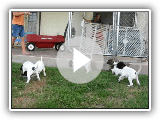 English Pointer Puppies – Bird Hunting Dogs
English Pointer Puppies – Bird Hunting Dogs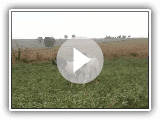 kinigi me pointer 1
kinigi me pointer 1 English Pointer Jazzie
English Pointer Jazzie
Very popular in Spain